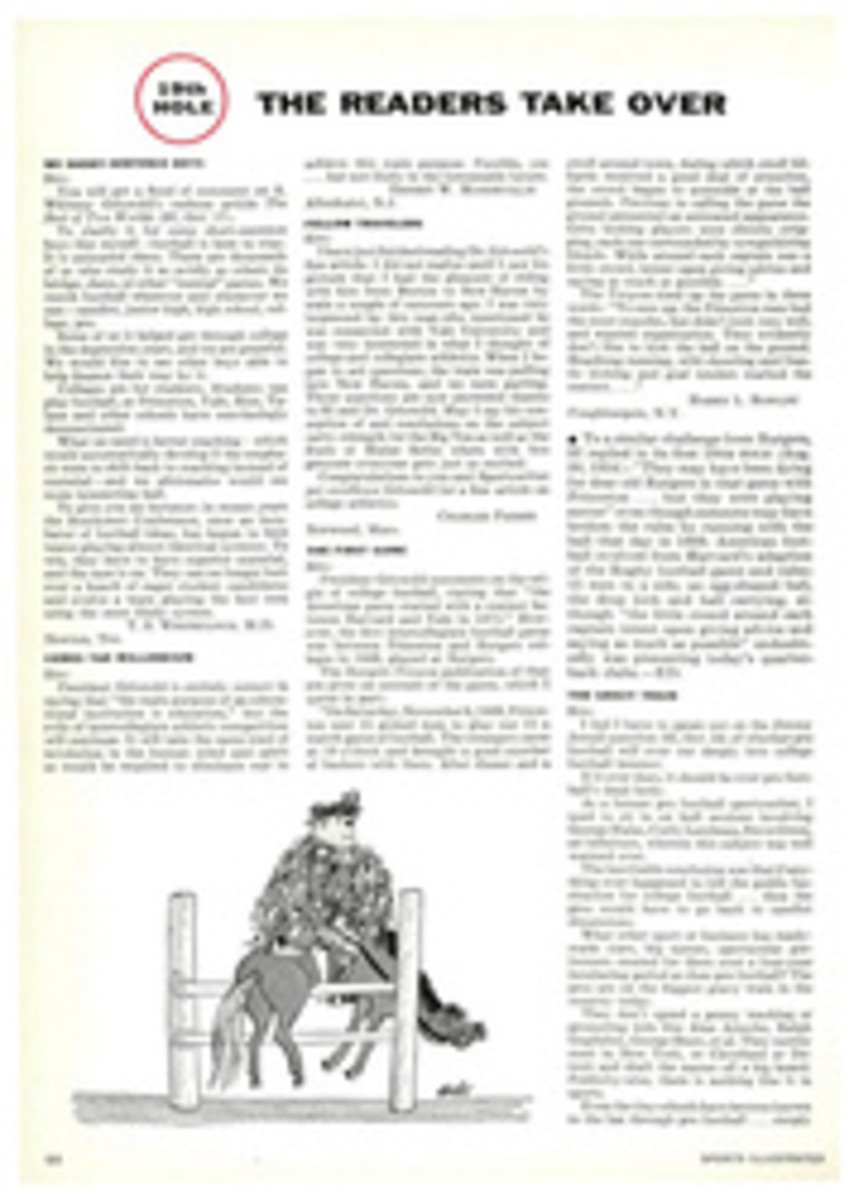
ARMOR THAT DOES AS MUCH HARM AS GOOD
The 11 pounds of complex, specially fashioned armor shown in detail on the opposite page represent the maximum in protection which 70-some years of football playing have developed for the player on the field. Over the years more and more pieces of padding and plating have been added as the game grew rougher, until today the average young man suited up looks and often acts more like St. George armed to battle a dragon than an athlete playing a friendly game.
Normally, the proposition that the more protective equipment a boy wears the less liable he is to injury would impel immediate agreement. To the scientific eye of safety experts at the Cornell Aeronautical Laboratory at Buffalo, however, today's equipment is an unscientific patchwork of steel-hard fibers and plastic which not only fails to protect the wearer but has converted him into a human battering ram.
Since 1951 a C.A.L. research team, headed by Edward R. Dye and sponsored by Sports Products, Inc., has been taking the first scientific look at the full range of body armament. (This same group also conducted the automobile-crash-injury study which was followed by cars' being equipped with safety belts and dashboard padding.) With Cornell University's trainer Frank (Doc) Kavanagh, the scientists studied movies of games to determine how injuries occur and then—in the lab—leveled bruising blows at every piece of equipment to test its protection power. As a result of their findings (summarized on the opposite page) Dye and Kavanagh have, for the first time, applied recognized principles of mechanics and engineering to the design of protective devices.
The first piece to be redesigned is football's most lethal weapon—the helmet. During the past 23 years half of the 409 direct gridiron fatalities have resulted from head injuries. So far this season three out of four deaths have been caused by blows to the head. The Cornell tests show that the helmets of today are inadequate to withstand a concussion-causing blow.
From the outside the new Cornell helmet looks like any other, except that the top is slightly arched to give added strength. Inside, however, lies the unique difference (drawings below). Whereas standard helmets rely on either a series of straps or strips of padding to protect the head and keep it in place, the new headgear combines elements of both. Across the top is a "geodetic suspension system"; around the equator is a "beam pad."
Under impact, the network of nylon suspension straps disperses the force of the blow over the entire head, thus reducing the danger at any one point. The pad reinforces the normally weak sides and is so constructed as to hug the skull, further smothering the blow and keeping the helmet squared on the head. And to protect "the other guy," the hard shell is cushioned with a band of energy-absorbing plastic.
Dye and Kavanagh have also developed a cleat (below left), to reduce knee and ankle injuries, and more protective knee and thigh guards. Of all the devices designed, however, the shoulder pads would literally change the shape of things. Instead of the stiff, loose-fitting pad which sits atop the shoulders, theirs is a soft, close-fitting pad, much akin to heavy underwear, that covers the chest and back. It's a sloping-shoulder affair which, besides protecting, will give every footballer a Brooks Brothers look.
ILLUSTRATION
JAMES CARAWAY
TWO ILLUSTRATIONS
JAMES CARAWAY
CORNELL CLEAT, a lightweight aluminum ring, eliminates locking action of standard cleats, allows pivoting on foot.
SIX ILLUSTRATIONS
JAMES CARAWAY
CORNELL HELMET (right) withstands blow and transmits impact over head, whereas headpiece with only padding (center) dents onto head, and helmet with only straps (left) also twists against skull. New helmet proves four times more protective.
Face guard, say experts, is "legalized murder." while protecting wearer, it can smash in an opponent's nose and jaw if he isn't wearing one too.
Rib pads are fine as far they go, but they not go far enough, back, spine, diaphragm and spleen are left vulnerable to serious injury.
Knee pad is designed to protect "other guy," but study shows half-inch pad is not thick enough to keep bony joint from being used as a weapon.
Helmet, made of hard, unyielding material, makes a good offensive cudgel, but laboratory tests prove that every conventional type of headgear now being worn fails to protect the wearer's own head.
Shoulder pads generally absorb head-on impact but jam into neck under blow from the side. Too, the clavicle is not covered. Pads are held down only by loose underarm straps and thin, tear-away jersey.
Hip and kidney pads are faulty on two counts: 1) they fail to fully cover kidneys; 2) stiff fiberboard lacks sufficient underpadding, particularly at the edge, to cushion the shock of crushing body block.
Thigh guard protects only front of leg and, like knee pads, fits into pants pockets. In action, pads may shift around the leg and even when in place can dig into the muscle under blow, causing charley horse.
Shoe cleats, Cornell Aeronautical Laboratory researchers find, are a major cause "of injury. Besides gouging an opponent, they lock player's foot to the ground, and when he tries to pivot or is forcibly hit, the torque wrenches or tears the ankle and knee joints.

